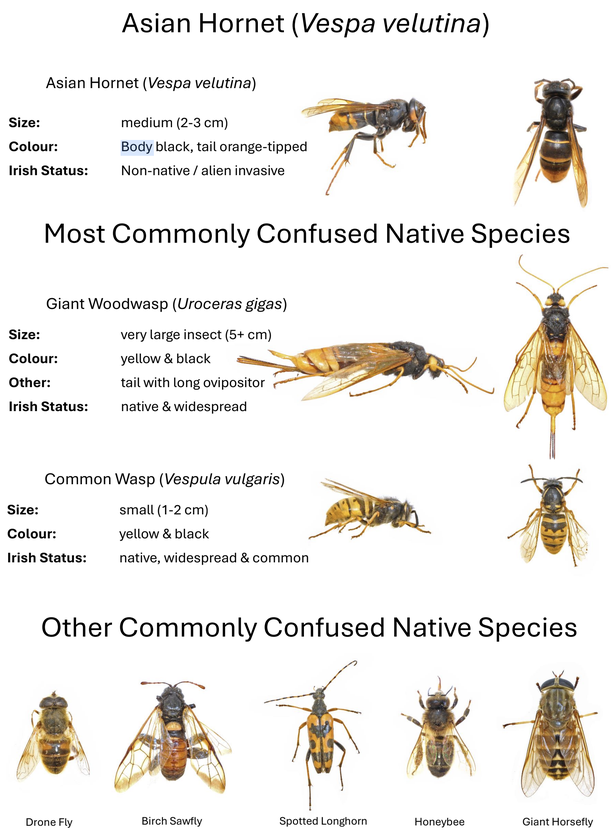Yellow Legged Hornet Confirmed in Ireland
Ireland has now recorded its second confirmed detection of the invasive Yellow Legged hornet (Vespa Velutina Nigrithorax ), a species that poses a serious threat to pollinators and biodiversity.
The most recent case occurred in August 2025, when a vigilant member of the public in Cork City correctly identified a Yellow Legged hornet and reported it through the National Biodiversity Data Centre’s Invasive Species Watch portal. This insect, known for preying on honeybees, triggered an immediate government response aimed at locating and eradicating any further evidence of the species on the island.
The only previous confirmed detection occurred in April 2021, when a single specimen was discovered in a garage on Dublin’s northside. Verified by Dr A. O’Hanlon of the National Museum of Ireland, that insect was preserved in the museum’s collection. In both cases, the route of introduction remains unknown and no evidence of established nests was found. In 2004, the arrival of one mated Asian Hornet queen to the port of Bordeaux, France, is confirmed (genetic testing), as responsible for the spawning of all of north western Europe, by this apex predator.
Image of the dead Yellow Legged Hornet trapped in Cork in August 2025. Note its scale in relation to a 2 euro coin. Happy to credit photographer when identified!
The Scale of the Threat
A single fertile Yellow Legged hornet queen can establish a nest capable of producing thousands of offspring in a single season.
One nest may house 6,000–13,000 hornets by late summer.
Among these, several hundred new queens can emerge in autumn.
Each new queen has the potential to overwinter and start a fresh colony the following year.
This exponential growth means that even one undetected nest can lead to a rapid and widespread population within just a few seasons, making early detection and swift eradication essential.
Identification and Risk
The Yellow Legged hornet can be difficult for the untrained eye to distinguish from other yellow-and-black stinging insects. It measures 2.5–3 cm in length, with:
Dark antennae and a long orange face
A brown or black thorax
A black abdomen marked by a single yellow band near the tip
Yellow lower legs
A small, retractable stinger (usually not visible)
Government produced chart describing the Yellow Legged Hornet and some easily misidentified species
This species is a highly effective predator of honeybees, wasps, bumblebees, hoverflies, and spiders — all essential pollinators for crops and wild plants. If colonies establish in Ireland, the impact on pollination and biodiversity could be severe.
Image of primary nest being constructed; secondary nest in tree. Photos of nests courtesy of John De Carteret, Jersey Yellow Legged Hornet Team. NOTE: DO NOT APPROACH SUSPECTED NESTS AS ASIAN HORNETS WILL ATTACK TO DEFEND THEIR NESTS.
Government Response
The National Parks and Wildlife Service (NPWS) and the Department of Agriculture, Food and the Marine (DAFM) have stepped up surveillance and monitoring, focusing on:
High-risk entry points, including ports, airports, and major distribution hubs
Strategic trapping near confirmed detection sites in Cork City and Dublin
Nationwide monitoring through the sentinel apiary programme, run with volunteer beekeepers
Minister of State Malcolm Noonan has acknowledged the value of public vigilance while stressing the need for accuracy:
“It is important there is no overreaction to sightings of large native insects such as wood wasps or social wasps. Other species must not be harmed or destroyed as a result of these findings.”
Public Action
Any suspected Yellow Legged hornet sightings should be reported — with a photograph if possible — immediately through the National Biodiversity Data Centre’s Invasive Species Watch portal at https://records.biodiversityireland.ie/record/invasives#7/53.455/-8.016 or via the NBDC mobile app. (https://apps.apple.com/ie/app/biodiversity-data-capture/id906361120)
Further information, including identification guides and updates, can be found at:
NPWS: www.npws.ie
Asian Hornet Alert: www.biodiversityireland.ie/asian-hornet-alert
Email: ias@housing.gov.ie
Use your phone camera to scan the code to the left for easy access to reporting a find.
If you suspect that you have seen a Yellow Legged hornet, report it immediately (with a photo if possible) to the National Biodiversity Data Centre via biodiversityireland.ie
Contact invasives.ie or scan to make a report.
If you have an apiary and want to report a suspected Yellow Legged hornet or have concerns for bee health, contact the Horticulture and Plant Health Unit of DAFM. E-mail: beekeeping@agriculture.gov.ie.’
DO NOT APPROACH SUSPECTED NESTS AS ASIAN HORNETS WILL ATTACK TO DEFEND THEIR NESTS.




